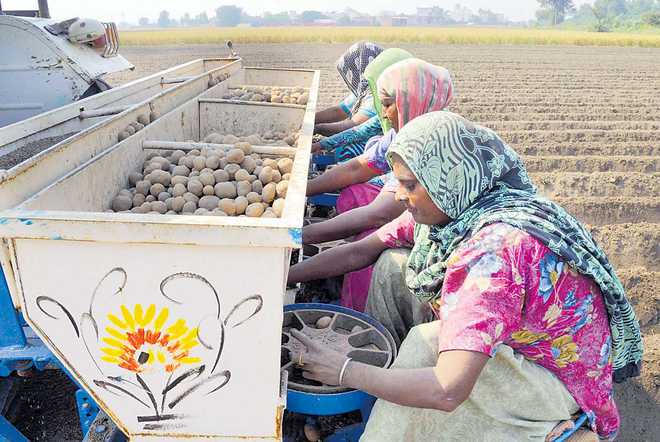
Capital intensive farm technologies have reduced employment opportunities for agricultural labour. AFP
Sukhpal Singh and Shruti Bhogal
AGITATIONS by farmers for debt waiver in many states have drawn attention to the ailing agricultural sector and the economic crisis being faced by farmers across the country. There is no doubt to the criticality of these issues being addressed. However, there exists a section of people without public voice – landless labourers – who often remain oppressed, succumbing to deprivation. The state of Punjab, hailed for food grain production, is tainted by the socio-economic woes of its rural labourers.
The recent agitations by rural landless labourers that spread across villages of Punjab – to name a few, Jhaloor, Baupur and Gowara – point towards the heightened desperation of this section. In 2008, landless labour in over two dozen villages of Mansa, Sangrur and Bathinda undertook mass agitations for homestead land that turned violent. Despite assurances from the previous state government, these labourers continue to be deprived of their basic rights of living. Eight years later, the struggle of the landless labour persists, fighting for their land rights.
Landless labour is a vital factor of agricultural production; their productivity and earnings being an important determinant of the level of economic prosperity. Despite their indispensability, they continue to suffer silently, leading a life of poverty and pauperisation. Like farmers, they too are indebted especially to landlords or other non-institutional sources. But their ongoing fight is not for monetary support. It is for physical, mental and financial security, in the form of land for farming and shelter, as per their right under the Land Consolidation Act, 1961.
Commercialisation of agriculture has brought even the common land (shamlat) and other fallow land under cultivation. As a result, the landless labourers are deprived of land for grazing their animals, obtaining firewood and even for nature’s call. They have been forced to sell off their livestock, which was a major support. Moreover, modernisation of the agricultural sector through capital intensive technologies has reduced employment elasticity, making labour of this sector redundant.
A survey by the Department of Economics and Sociology of Punjab Agricultural University, Ludhiana, found that over 90 per cent of paddy and 70 per cent of wheat are harvested with combine harvesters. This points to the shrinking of labour employment. Out of a total workforce of 99 lakh in Punjab, 35.6 per cent are engaged in agricultural sector, either as cultivators (20 lakh) or agricultural labourers (15 lakh). Our field survey, ‘Status of Agricultural Labour in Punjab (2017)’, reveals that labourers find work for merely two months in a year in the agricultural sector. Moreover, alternative employment opportunities in rural areas are unpromising.
Punjab’s economy has been unable to exhibit developmental transition of human resource, in which the surplus labour from agricultural sector progresses or is pulled into the industrial sector and further on into the service sector. As a result, much of the labour movement from agricultural sector to industrial is of ‘push’ type due to non-availability of work. The report of the Punjab State Farmers Commission, ‘Status of Farmers Who Left Farming (2008)’, reveals that about 2 lakh small farmers left farming during 1991-2001. A large number ended up joining the pool of oppressed and deprived labour.
Considering that agriculture sector is a livelihood generator for the majority of our population, the problem of unemployment would continue to grow, unless there is a growing industrial or service sector to absorb the rural spills. Unfortunately, the situation of labourers in the industrial sector of Punjab is no better. This is particularly true in the post-liberalised era, as the industrial sector too is struggling due to viability issues. About 19,000 industrial units shut down in Punjab between 2007 and 2015. As a ripple effect, the labourers have been left jobless and forced to take up meagre work for survival. Resultantly, the income and consumption of this section is minimal, leading to further impoverishment.
In Punjab, of the total 6,926 suicide cases during 2000-2010, 43 per cent were of agricultural labourers. Of these, about 59 per cent were an outcome of heavy debt burden. The proportion of suicide victims among labourers is as high as that among farmers (18 suicides/lakh workers). However, the women of this section are more severely affected as the proportion of labour women among suicide victims is double (17%) that of farm women (8%). Recently, the state government announced debt waiver of small farmers; however, the labourers who continue to be under severe economic stress remained unaddressed.
The uplift of this section requires a comprehensive approach. To begin with, their legal entitlements need to be fulfilled. In the villages of Bhattiwal Kalan, Mander Kalan, Jhaneri and Kular Khurd in Sangrur, and Bina Heri and Surajpur in Patiala, landless labourers have set an example by leasing-in one-third of the common property land for joint farming. This model has been successfully working since 2008 in Benra village, and since 2014 in Balad Kalan, Gharachon, Jhaneri and Batriana villages of Sangrur. Replicating it across the state can assure the much needed security.
However, a permanent solution lies in implementation of measures like rural industrialisation, agro-processing and development of rural infrastructure. This will have trickle-down effects. Ensuring effectiveness and enhancement of minimum wages and allotting one-third of the common property land as plots of 150 yards to landless labour families for house construction is vital for their sustenance. The Land Ceiling Act, 1972, stipulates maximum permissible irrigated land owning of 7 hectares. There is a need to distribute/lease-out surplus land, on nominal rates, among landless labourers and resource-poor cultivators. In addition, like small farmers, this section also needs debt waiver, particularly from non-institutional debt, for they too are victims of prolonged indebtedness.
The destitution of labour class exemplifies an apathetic society. They continue to languish in a perpetual state of weakness and vulnerability. Today, when a major focus of public discourse is on ‘Sab ka Vikas’ (development of all), labourers sweat for fulfilment of their basic necessities.
Sukhpal Singh is head and Shruti Bhogal teaching assistant at the Department of Economics and Sociology, PAU, Ludhiana.



























